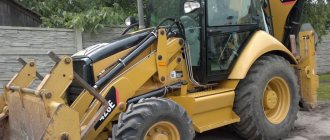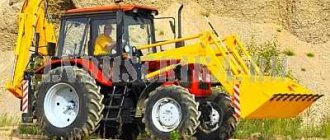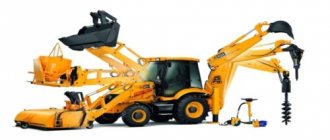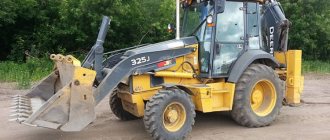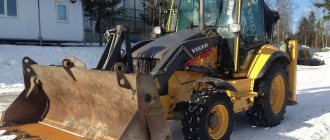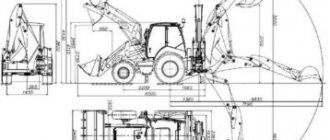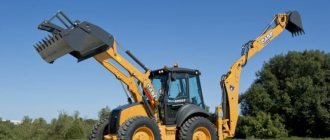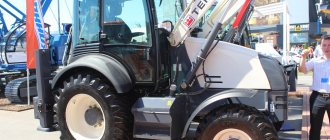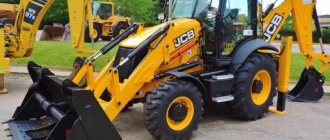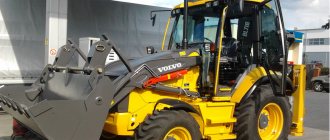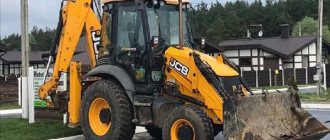JCB is a global giant of construction equipment, special equipment and spare parts from the UK. Since the mid-20th century, the brand has been producing loaders, tractors, dump trucks and other machines. The manufacturer's assortment includes more than 300 items.
Many people are interested in what pressure should JCB excavator wheels have. In fact, this question is very correct and justified. After all, the operation of the equipment, as well as the safety of the driver, directly depends on this indicator.
Standards for popular loaders manufactured by JCB
Before taking measurements, it is necessary to have information. What are the normal tire pressures for JCB 3CX, 4CX, and other well-known excavators? There are several ways to find out about this:
- read the information on the wheel;
- look in technical documents if the data is not indicated on the bus;
- contact the manufacturer or competent specialists;
- try to calculate it yourself.
In order for the calculations to be correct, the main thing that should be taken into account is the ply of the rubber, the maximum permissible weight, and the characteristics of the loader.
JCB 3CX tractor
This is the most famous of all JCB brand loaders. It is a universal technique that can work in almost any conditions. The price corresponds to the quality.
All wheels (both those installed at the front and rear) of the 3CX excavator can turn in different directions. Resistance to solar radiation, chemicals, and temperature changes is observed. The hydraulic hoses function perfectly.
This loader is equipped with an economical engine that fully complies with modern standards. And all thanks to a modified fuel combustion system, which also increases power.
JCB 4CX excavator
The powerful diesel engine of the loader has a direct fuel injection system. By controlling the hydraulic flow rate, the hydraulic pump is switched off when shifting into fourth gear. The price of this excavator varies depending on the year of manufacture.
JCB 160W
This is a reliable, safe and easy to maintain option. The JCB loader engine has a power of 130 hp. Vibrations occurring in hydraulic cylinders are damped thanks to a special device. In this regard, negative mechanical impacts in the excavator are reduced.
General data for all JCB loaders
The spread of indicators is quite large. It will be much faster to use a pivot table. It is suitable for all types of JCB loaders (4CX, 3CX, etc.):
| Number of layers of excavator rubber | Loader wheel size | Optimal backhoe loader tire pressure | |||
| During the summer time | In winter | ||||
| Front | Behind | Front | Behind | ||
| 8 | 23*5 | 6,5 | 6,5 | 6,4 | 6,4 |
| 8 | 4.00-8 | 9 | 9 | 8,9 | 8,9 |
| 10 | 23*5 | 7,75 | 7,75 | 7,65 | 7,65 |
| 10 | 5.00-8 | 10 | 10 | 9,9 | 9,9 |
| 10 | 6.00-9 | 8,5 | 8,5 | 8,4 | 8,4 |
| 10 | 6.50-10 | 7,75 | 7,75 | 7,65 | 7,65 |
| 12 | 6.00-9 | 10 | 10 | 9,9 | 9,9 |
| 12 | 6.50-10 | 9 | 9 | 8,9 | 8,9 |
| 12 | 7.00-12 | 8,5 | 8,5 | 8,4 | 8,4 |
| 14 | 16*6-8 | 8,5 | 8,5 | 8,4 | 8,4 |
| 14 | 18*7-8 | 9 | 9 | 8,9 | 8,9 |
| 14 | 21*8-9 | 9 | 9 | 8,9 | 8,9 |
| 14 | 23*9-10 | 7 | 7 | 6,9 | 6,9 |
| 14 | 6.50-10 | 10 | 10 | 9,9 | 9,9 |
| 14 | 7.00-12 | 9 | 9 | 8,9 | 8,9 |
| 14 | 28*9-15 (8.15-15) | 9 | 9 | 8,9 | 8,9 |
| 14 | 8.25-15 | 8 | 8 | 7,9 | 7,9 |
| 16 | 16*6-8 | 9 | 9 | 8,9 | 8,9 |
| 16 | 18*7-8 | 10 | 10 | 9,9 | 9,9 |
| 16 | 21*8-9 | 10 | 10 | 9,9 | 9,9 |
| 16 | 23*9-10 | 8 | 8 | 7,9 | 7,9 |
| 16 | 7.00-12 | 10 | 10 | 9,9 | 9,9 |
| 16 | 28*9-15 (8.15-15) | 9,75 | 9,75 | 9,65 | 9,65 |
| 16 | 8.25-15 | 9,25 | 9,25 | 9,15 | 9,15 |
| 16 | 250-15 | 8,25 | 8,25 | 8,15 | 8,15 |
| 18 | 300-15 | 8 | 8 | 7,9 | 7,9 |
| 20 | 250-15 | 9,5 | 9,5 | 9,4 | 9,4 |
Knowing what the tire pressure should be on the JCB 4CX (and all others) and how to find out, you can safely proceed to adjustment (if necessary).
A little history
JCB was one of the first manufacturers of backhoe loaders. The company’s “firstborn”, released back in 1954, was called Major Loadall MK. It was a regular tractor with a Fordson engine, a cable loader and excavator attachments. At that time, 550 units rolled off the assembly line.
Since 1956, a new model was launched, which was called Hydra-Digger. It featured longer excavator equipment. Until 1960, about 1,800 of these models were produced. At the same time, development of our own chassis began, which led to the creation of the JCB4 model. It was the first backhoe loader to feature the signature yellow color and a 180-degree rotatable seat. Over three years of production, one and a half thousand copies were sold.
Between 1961 and 1967, approximately 7,000 JCB 3 models rolled off the production line, featuring a movable carriage, supports and new excavator equipment. In 1963, some changes were made to the model. In particular, a hinged side door, an extended handle, and a new engine (Fordson or BLMC) were installed. And the index “C” was added to the name.
The new generation, released in 1967 under the name JCB 3C II, became a real long-liver. It was produced until 1980. In thirteen years, about 40,000 copies were sold. This version was distinguished by a curved arrow and a sliding door. Later modifications received a semi-automatic transmission and a pneumatic boom.
The next long-liver was put into production in 1980. Its name was JCB 3CX. The use of a double-jaw bucket allowed this version to dig holes up to 5.53 meters deep. Past modifications were limited to four meters. The 3CX model was produced for 11 years and sold 74,000 copies worldwide. It is so reliable that it still serves faithfully on construction sites.
In 1990, the JCB 2CX backhoe loader appeared, which has a 4 x 4 x 4 wheel arrangement. And 1991 became a turning point for the company. The 3CX model was completely redesigned: from the chassis to the design. At the same time, the company launched the production of a powerful all-wheel drive JCB 4CX model, which had coordinated turning of all wheels and the so-called “crab drive”.
In 2002, the company focused on design. It introduced a servo drive as well as a Powershift transmission into its flagship model. And 2005 was marked by the release of an updated model with a solid hood, new hydraulics, its own engine and a number of other less significant changes. This is where the story of our today's hero began.
How to pump up your tires yourself
If you notice that the required indicator is insufficient when checking the tires of an excavator, you should follow the following procedure:
- Check the tires (both front and rear axle). They must be inserted into the inflation frame or simply installed correctly on the JCB loader.
- Select the required value on the prepared device. It is permissible to exceed the recommended value by a maximum of 1.38 bar. You can also use an air hose.
- Perform the procedure for inflating air into the rubber of a JCB excavator. To do this, attach the hose to the valve, stand behind the rolling point and inflate the tire to the desired level.
Dear customers! If you have any questions (regarding tires, JCB excavators, engines, etc.), call our managers. Specialists will answer everyone, show patience and tact.
Possibility of changing attachments
Any modification of the excavator provides for a quick change of attachments. Forks or a jaw bucket can be installed in place of the work bucket located at the front of the JCB loader.
The front bucket is also removed, and instead of it a telescopic or classic boom is installed, as well as buckets of various modifications.
JCB 3CX attachments
Negative consequences
If the tire is not fully inflated, this will result in:
- to an increase in rubber temperature;
- reducing machine stability;
- increased friction with the road and further increase in load on the fabric;
- reducing the service life of the wheel;
- increased fuel consumption.
When the tire pressure exceeds the norm, the owner may encounter the following problems:
- a multiple increase in the likelihood of a puncture or cut;
- overload on the excavator chassis;
- danger of explosion of forklift rubber;
- overturning equipment.
So, mistakes with tire pressure can be fraught with negative results for both the JCB excavator and the person. And it is always a financial loss.
Description of the main characteristics
To fully appreciate the power and capabilities of special equipment, you should consider its main technical characteristics.
| Operating power | 63 kW |
| Operating weight | 7.37 t |
| Digging Bucket Capacity | 0.3 m3 |
| Bucket width | 0.6 m |
| Digging depth | no more than 4.24 m |
| Front bucket volume | 1 m3 |
| Front bucket width | 2.23 m |
| Maximum vehicle speed | no higher than 37 km/h |
| Fuel tank volume | 143 l |
| Front loader lifting capacity | no more than 1.85 t |
| Unloading height | no more than 3.23 m |
| Fuel consumption | 8 liters per hour |
| Operating air temperature | -20°С–46°С |
The JCB 3CX has a high travel speed for this class of machine, which reduces turnaround time. The increased volume of the fuel tank and reduced fuel consumption allow the equipment to be operated throughout the work shift without the need for refueling.
Main dimensions of JCB 3CX
The excavator body is made of high-strength steel, due to which it is able to withstand high work loads.
Cabin
Like all its siblings, the JCB 3CX Super has a spacious, rounded cab. Its characteristic features are tinted windows and the absence of crossbars. This appearance has become one of the symbols of the British brand's products. The cabin design turned out to be very successful and comfortable. However, there is also a drawback - for the sake of aesthetics, all glass is glued into the openings. Considering the specific nature of the operation of such equipment, the risk of glass damage is quite high. And replacing it is now a labor-intensive and lengthy process. Excavator and loading booms are externally in complete harmony with the cab and chassis.
Brakes
The creators paid a lot of attention to the braking system. As a result, when you press the pedal, you can get a sharp and unambiguous, but at the same time predictable response. The brakes are very reliable, but their harshness takes some getting used to. When driving on ordinary streets, it is recommended to fasten your seat belts and use the “floating ride” mode. It eliminates vibrations of the fork of the loader, which can weaken the entire device on bumps.
Operation, maintenance
For ease of maintenance, all important components of the power unit, transmission, and hydraulic system are located on one side. This facilitates inspection and reduces the time required for the operator to check the technical condition of the machine.
The loader does not have an air pre-filtration system. Cleaning occurs due to the release of exhaust gases from the exhaust pipe. This system extends the life of the air filter until scheduled replacement.
Thanks to the hydraulic oil fine cleaning system, the working fluid change interval is increased to 5000 operating hours.
Motor
As already mentioned, one of the main distinguishing characteristics of the 3CX Super backhoe loader is the engine. It was developed specifically for this model. The JCB 3CX Super engine, according to the company, has a huge reserve of torque almost from idle. Many original solutions were made in the design of the engine cooling and power supply systems. So, we installed a water separator filter. It traps moisture trapped in the fuel. The oil filter was equipped with a counterflow valve. It holds the oil in the housing when the engine is turned off. This solution not only makes maintenance more comfortable, but also makes it possible to start the engine on clean, filtered oil.
The air supply system has a self-cleaning filter. The air intake was moved a little to the side. This makes the incoming air cleaner and cooler. They also took care of the ease of servicing the motor - all service points are located on the left side. So you no longer need to walk around the excavator to get this or that element.
Interior
Inside the cabin, everything is strict, restrained and very comfortable. The predominant colors are black and gray. Together with tinted glass, they give the interior a certain elegance. The interior layout has remained virtually unchanged since 1997. And this is not archaic at all, but time-tested convenience and ergonomics.
The cabin has two workstations. One of them is provided for the loader operator. The steering column has become a little “slimmer”. It has two steering column levers. The first controls the transmission, and the second controls the lighting equipment. Below the steering wheel is an indicator panel. It is topped with the JCB emblem. Having turned the chair 180 degrees, we find ourselves at the excavator operator’s workplace.
Here everything is done according to the traditional scheme for passenger cars. To the right is the glove compartment and to the left is the JCB 3CX Super instrument panel. Reviews from people who have worked with this equipment show that the ventilation system deserves special attention. Firstly, diffusers are scattered throughout the cabin, they do their job perfectly. And secondly, the operator has the ability to open the rear window.
